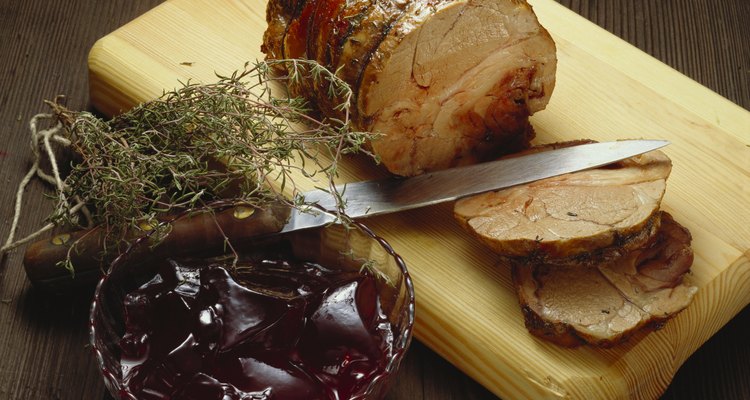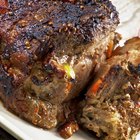
Pork has been through a number of changes since the 1970s, when it was demonized for its high fat content. The pork industry has responded by creating ever-leaner pork, with many cuts now having no more fat than chicken. This was the inspiration for the slogan that refers to pork as "the other white meat." The spread of Southern-style pulled pork, and the rediscovery of heritage hog breeds like the Tamworth and Berkshire, have revived interest in well-marbled, slow-roasted pork.
Selecting a Cut
Not all cuts of pork are well-suited to the long cooking times needed for slow, low-temperature cooking. Leaner cuts, such as the loin or sirloin, will be left dry and tasteless by this cooking method. The best cuts are those with a significant quantity of marbling and fat, which will eventually cook out -- but until then -- keeps the pork moist and juicy. The most popular cuts for slow cooking come from the shoulder. Any pork shoulder roast will work, but the butt -- or Boston butt, as it's sometimes called -- is a good choice because of its uniform shape.
Preparing the Roast
There are several ways to prepare the pork for roasting. Score any surface fat with a sharp knife and rub it with your favorite dry seasoning mixture, and let it sit overnight to absorb the flavors. Alternatively, use a mixture of two parts coarse kosher salt to one part sugar, which will firm the meat's texture slightly and give a darkly browned outer surface. You could also rub your roast with Dijon mustard, minced garlic, fresh rosemary or sage, or any other flavorings you like. Leave the roast overnight in your refrigerator, to acquire flavors.
Browning and Low-Temperature Cooking
Slow, low-temperature cooking is a powerful technique, but it does have one shortcoming: Much of the flavor in roasted meats comes from browning, and low-temperature cooking won't brown the pork. Browning is caused by a process called Maillard reactions, created when the amino acids in the meat's proteins are altered by exposure to heat. The amino acid molecules break down into fragments and rejoin in more complicated molecules, producing a range of new flavors. To get the benefits of both slow-roasting and still enjoy the savory flavors of browned pork, sear it in a heavy skillet before roasting.
Slow Roasting
Preheat your oven to 275 F. Place the pork on your roaster's rack, and put it on the middle rack of the oven. Cook slowly for four to five hours, until it's fork-tender. This usually takes place at an internal temperature of 185 F to 200 F, when the connective tissues have broken down. Finish at 450 F for 30 minutes to brown the roast, if you haven't already done so. Cover loosely with aluminum foil and rest the roast for 15 to 20 minutes before carving.
Related Articles

How to Cook a Moist & Tender Center Cut ...

The Secret to Cooking Tender Pork

How to Cook Shredded Pork Roast in a ...

How to Braise Pork

What Is the Safe Cooking Temp for a ...

How to Convection Roast a Brisket

How to Cook a Boston Butt in a Crock ...

How to Bake a Pork Loin Center Half

How to Cook Souvlaki in the Oven

How Do I Tell If Pork Has Turned Bad?

How to Cook Pork & Sauerkraut in an ...

Can You Cook Beef Shank Cuts Like a ...

How to Barbecue Bologna on a Charcoal ...

Instructions for Baking a Smoked Ham ...

How to Cook Pork Pinwheels

How to Roast a Pork Blade Cut

Barbecue Tips for Pork Rib Brisket

How to Bake Moist Tender Sliced Pork ...

How to Cook Jerk Pork in the Oven

How Can I Bake a Pork Loin Roast So ...
References
- "On Food and Cooking: The Science and Lore of the Kitchen"; Harold McGee; 2004
- "Professional Cooking"; Wayne Gisslen; 2003
- Fine Cooking; Slow-Roasted Pork Shoulder with Carrots, Onions, and Garlic; Tasha DeSerio; December 2008
- Epicurious; Slow-Roasted Pork with Lime Mojo; January 2000
- Epicurious; Slow-Cooked Hoisin Pork Roast with Green Onions; October 2003
Writer Bio
Fred Decker is a trained chef and prolific freelance writer. In previous careers, he sold insurance and mutual funds, and was a longtime retailer. He was educated at Memorial University of Newfoundland and the Northern Alberta Institute of Technology. His articles have appeared on numerous home and garden sites including GoneOutdoors, TheNest and eHow.
Photo Credits
Eising/Photodisc/Getty Images